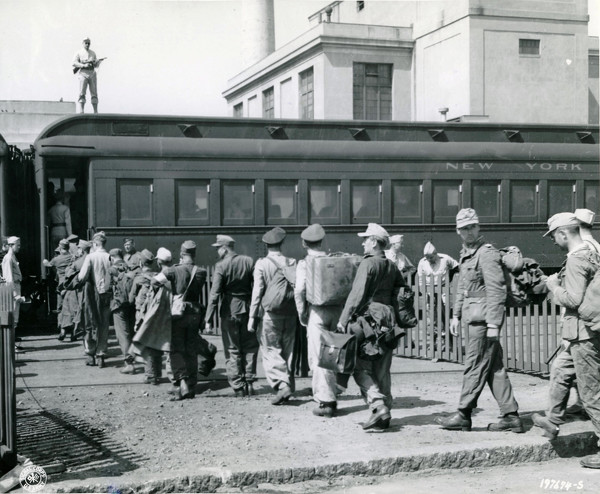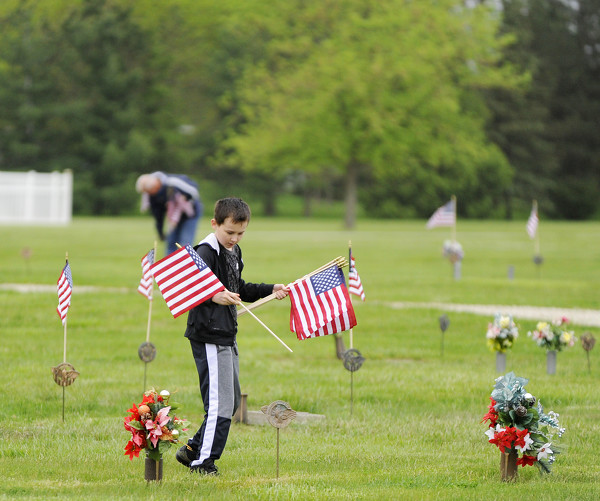Saturday, May 23rd, 2020
County held German POWs
Celina 4-H camp part of book on WWII history
By William Kincaid

Submitted Photo
Dr. James Van Keuren, author of "World War II POW Camps in Ohio," shared this imag of prisoners of war in the United States from his book. The book contains a section discussing the former POW camp at the 4-H camp east of Celina on Grand Lake.
CELINA - In the summer of 1944, 294 German prisoners of war, most of them teenagers, were sent to the 4-H camp at Harbor Point in Celina, offering the area a much-needed workforce when many able-bodied local men were serving their country in World War II.
They were part of a wave of more than 6,000 World War II POWs who were sent to Camp Perry near Port Clinton and its branch camps in Columbus, Rossford, Cambridge, Bowling Green, Defiance, Marion, Parma, Wilmington and Celina, said Dr. James Van Keuren, author of "World War II POW Camps in Ohio" and a retired professor of educational administration and dean of the Dwight Schar College of Education at Ashland University.
The United States overall in World War II took in more than 425,000 Axis POWs, including 371,000 Germans, 50,000 Italians and 3,900 Japanese, because Great Britain simply didn't have the room, Keuren said.
In stark contrast to Allied counterparts imprisoned overseas, the Axis prisoners were afforded humane conditions, some even eating better than average American citizens - to the chagrin of some Ohioans.
"Celina was one of these branch camps that from July 1944 to then October, there were close to 300 POWs there that harvested tomatoes, worked in some canneries," Keuren said.
Of the German POWs imprisoned at the 13-acre 4-H camp, 291 were privates between the ages of 17 and 18. Also imprisoned there was a lone noncommissioned officer and two sanitary personnel, he said.
"The war department assisted Camp Perry in selecting the sites, and in northwest Ohio, it was obvious that there was a labor shortage," Keuren said in a phone interview. "The prisoners were screened before put into those positions. So the more hostile prisoners, especially the Germans, they stayed on the base camp and didn't go out. Italians ended up going to the Toledo area at Rossford and doing some work there."
The Celina camp was surrounded by a high fence and guard towers, Keuren noted. Four small houses served as the canteen, administrative office, chapel and store, while a large barracks served as the kitchen and mess hall.
Keuren said 98 tents were set up as housing, each containing three men.
"A separate building was used as a showering facility and latrine," Keuren wrote in the book. "Part of this building was reserved for use by the 70 American soldiers and officers who slept in cabins at the camp. An infirmary provided light and moderate care by a visiting doctor each day, while severe cases were transferred to the base hospital at Camp Perry."
The camp had a library, and military personnel promoted democracy as well as American ideals and values to prisoners.
Prisoners woke up at 6 a.m., ate breakfast at 6:30 a.m. and were transported to worksites at 7:30 a.m. They worked for eight hours before returning to the Celina camp, where the lights were turned off at 9:30 p.m.
"The prisoners got 80 cents a day," Keuren said, adding most of the money was spent in the camp cafeteria, and prisoners had a fondness for menthol cigarettes and Coca-Cola. "You couldn't keep enough Coca-Cola in the camps."
According to his research, many Ohio farmers spoke favorably of the German POWs working their land.
"The Germans were really hard workers," he said, noting they got straight to business when they arrived at work. "The Italians were more relaxed."
Some Ohio farmers wrote to the war department asking for the POWS to stay longer.
"So they were leaving in the fall of 1945, and they were all concerned because they needed the POWs to do the harvesting," Keuren said.
The Celina prisoners were well fed and supplied with coffee, butter and sugar. Unlike the German and Japanese leaders, the U.S. government followed the Geneva Convention to a T.
"We really treated the POWs here top-notch, moreso than the rest of the world," Keuren said.
He said he came across a Port Clinton couple who had visited Germany. He said their tour guide, upon learning of their hometown, revealed he had been a POW at Camp Perry, telling them he "had the best time of (his) life. Good food. (He) got the best treatment."
Some Americans, though, accused the U.S. government of coddling the POWs.
"Here we are, we're treating these people," he said. "They got food as good as our GIs were at that time and probably a little bit better than the local residents were receiving during the rationing period."
Resentment of the Axis POWs popped up in Mercer County, Keuren said, pointing out some who had loved ones fighting overseas didn't like the idea of locals working with the German POWs.
"At Celina there were some hostile kinds of activities going on there," he said. "Supposedly … there were some attempts on those citizens that were working with the POWs. There was a couple of bomb attempts."
In mid-October, after the tomato harvest, the Celina camp prisoners were returned to Camp Perry. The last POW left Camp Perry for home in February 1946. The last POW left the United States in June 1946, he said.

Submitted Photo
Dr. James Van Keuren, author of "World War II POW Camps in Ohio," shared this imag of prisoners of war in the United States from his book. The book contains a section discussing the former POW camp at the 4-H camp east of Celina on Grand Lake.



